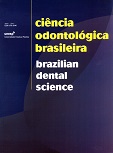Influência de fotopolimerizadores de luz halogena X led azul na dureza de resina composta
DOI:
https://doi.org/10.14295/bds.2005.v8i1.234Abstract
Esta pesquisa teve como objetivo verificar a profundidade de polimerização em resina composta, quando utilizados os fotopolimerizadores: de luz halógena (Optilux e Optilight 600) e de luz emissora de diodo (LED) LEC 470-I, através da mensuração da dureza superficial nos 2, 3 e 4mm de profundidade. Utilizou-se uma matriz de aço inoxidável para a obtenção dos corpos de prova e cada aparelho polimerizador formou um grupo, com 15 corpos de prova. Foi utilizada a resina composta Z100 (3M) na cor A3,, que foi fotopolimerizada por 40 segundos e armazenada em um recipiente contendo água destilada à 37 ± 2ºC, por 24 horas. As amostras foram embutidas em resina acrílica a fim de serem corretamente posi¬cionadas no aparelho Microdurômetro Digital Vickers, modelo FM - Future Tech. Realizado o acabamento e polimento, os blocos de resina foram submetidos ao teste de dureza onde receberam impressões a cada milímetro do compósito. Os dados foram submetidos ao teste ANOVA, (α =5%) e ao teste de Tukey (5%). As melhores condições foram verificadas para o Optilux (2mm: 136,63±9,35HV; 3mm:126,95±7,72HV) e as piores para o LEC 470 I (2mm:126,17±9,69HV; 3mm:117,65±6,90HV), independentemente da profundidade de polimerização; enquanto o Optilight ocupa uma posição intermediária (2mm:105,95±14,96HV; 3mm:80,83±16,30HV). Os aparelhos de luz halogena polimerizaram a resina nos 2, 3 e 4mm, já o aparelho de LED polimerizou o material apenas nos 2 e 3 mm da amostra. Concluiu-se que as amostras polimerizadas com os aparelhos de luz halogena apresentaram dureza superficial maior do que aquelas polimerizadas com o aparelho de LED.Downloads
Downloads
Published
How to Cite
Issue
Section
License
Brazilian Dental Science uses the Creative Commons (CC-BY 4.0) license, thus preserving the integrity of articles in an open access environment. The journal allows the author to retain publishing rights without restrictions.
=================




























